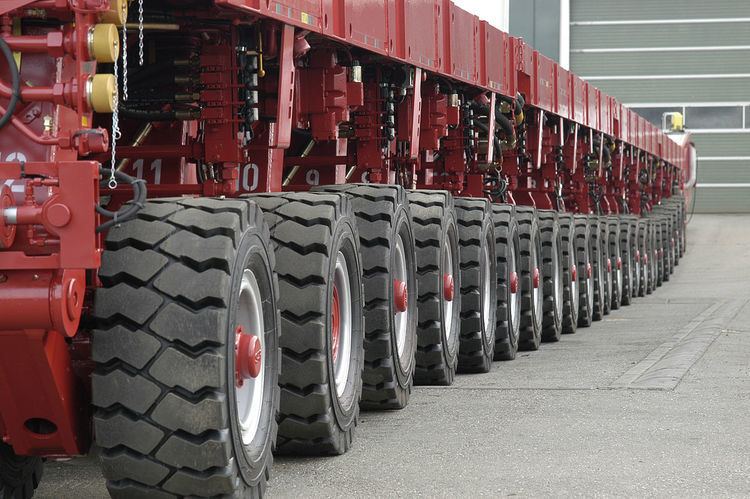 | ||
A self-propelled modular transporter or sometimes self-propelled modular trailer (SPMT) is a platform vehicle with a large array of wheels. SPMTs are used for transporting massive objects such as large bridge sections, oil refining equipment, motors and other objects that are too big or heavy for trucks. Trucks can however provide traction and braking for the SPMTs on inclines and descents.
SPMTs are used in many industry sectors worldwide such as the construction and oil industries, in the shipyard and offshore industry, for road transportation, on plant construction sites and even for moving oil platforms. Recently in addition, they have begun to be used to replace bridge spans in the United States, Europe, Asia and more recently Canada.
A typical SPMT has a grid of computer-controlled axles, usually 2 axles across and 4-8 axles along. When two (or more) axles are placed side-by-side, this is called an axle line. All axles are individually controllable, in order to evenly distribute weight and steer accurately. Each axle can swivel through 360°. The axles are coordinated by the control system to allow the SPMT to turn, move sideways or even spin in place. Some SPMTs allow the axles to telescope independently of each other so that the load can be kept flat and evenly distributed while moving over uneven terrain. Each axle can also contain a hydrostatic drive unit.
A hydraulic power pack can be attached to the SPMT to provide power for steering, suspension and drive functions. This power pack is driven by an internal combustion engine. A single power pack can drive a string of SPMTs. As SPMTs often carry the world's heaviest loads on wheeled vehicles, they are very slow, often moving at under one mile per hour while fully loaded. Some SPMTs are controlled by a worker with a hand-held control panel, while others have a driver cabin. Multiple SPMTs can be linked (lengthwise and side-by-side) to transport massive building-sized objects. The linked SPMTs can be controlled from a single control panel.
The first modular self-propelled trailers were built in the 1970s. In the early 1980s, heavy haulage company Mammoet refined the concept into the form we see today. They set the width of the modules to 2.44 m, so the modules would fit on an ISO container flatrack. They also added 360° steering. They commissioned Scheuerle to develop and build the first units. Deliveries started in 1983. The two companies defined standard units: a 4-axle SPMT, a 6-axle SPMT and a power pack. Over the years, more modules were added to this system to accommodate a range of payloads.
In 2016 ESTA (the European Association of Abnormal Load Transport and Mobile Cranes) published the first SPMT Best Practice Guide to help address the problem of trailers tipping over, which has happened on some occasions even though the operating rules and stability calculations have been precisely followed.
There are some shipbuilding companies using SPMT for carrying ship parts and constructing ships in China. They have reduced million dollars of cost that were consumed for transporting loads using gantry cranes. It is also the first companies which use SPMT to build ship in China. It means SPMT made in China has reached a world-class level.
